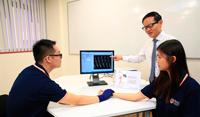 A research team at the National University of Singapore (NUS) has developed a soft, flexible and stretchable microfibre sensor for real-time healthcare monitoring and diagnosis.
A research team at the National University of Singapore (NUS) has developed a soft, flexible and stretchable microfibre sensor for real-time healthcare monitoring and diagnosis.
Highly sensitive and ultra-thin with a diameter of a strand of human hair, the sensor has been designed to be both simple and cost-effective to mass produce.
While wearable and flexible technology has gained significant interest in recent years, current devices have various limitations – for instance, they may not fit well on the skin or are uncomfortable to wear.
According to Professor Lim Chwee Teck from the Department of Biomedical Engineering at NUS Faculty of Engineering, who is the leader of the research team, “Our novel microfibre sensor can hardly be felt on the skin and conforms extremely well to skin curvatures. Despite being soft and tiny, the sensor is highly sensitive and it also has excellent electrical conductivity and mechanical deformability. We have applied the sensor for real-time monitoring of pulse waveform and bandage pressure. The results are very promising,”
The smart microfibre sensor developed by the NUS Engineering team comprises a liquid metallic alloy, which serves as the sensing element, encapsulated within a soft silicone microtube. The sensor measures an individual’s pulse waveform in real-time, and the information can be used to determine one’s heart rate, blood pressure and stiffness in blood vessels.
“Currently, doctors will monitor vital signs like heart rate and blood pressure when patients visit clinics. This requires multiple equipment such as heart rate and blood pressure monitors. As our sensor functions like a conductive thread, it can be easily woven into a glove which can be worn by doctors to track vital signs of patients in real-time. This approach offers convenience and saves time for healthcare workers, while patients can enjoy greater comfort,” added Prof Lim.
“Our microfibre sensor is highly versatile, and could potentially be used for a wide range of applications, including healthcare monitoring, smart medical prosthetic devices and artificial skins. Designed to be durable and washable, it is highly attractive for promising applications in the emerging field of wearable electronics,” said Prof Lim.
Researchers are currently refining the sensor design and reducing the size of its accessories to improve the user-friendliness of the device.
Pic: Professor Lim Chwee Teck
Author
Neil Tyler
Source: www.newelectronics.co.uk
